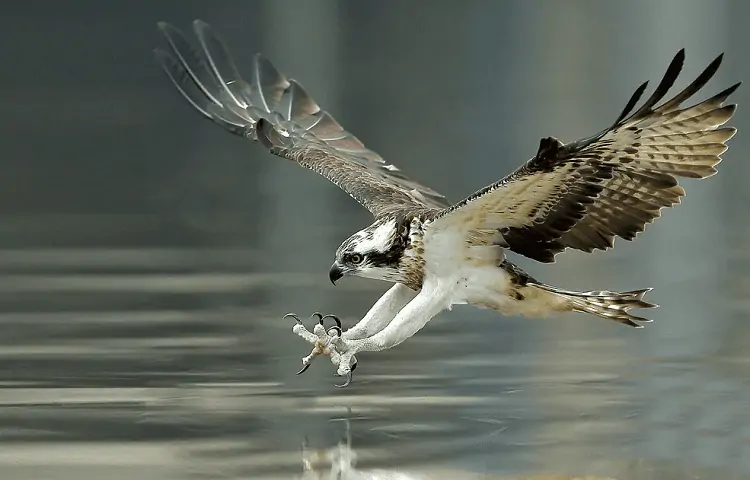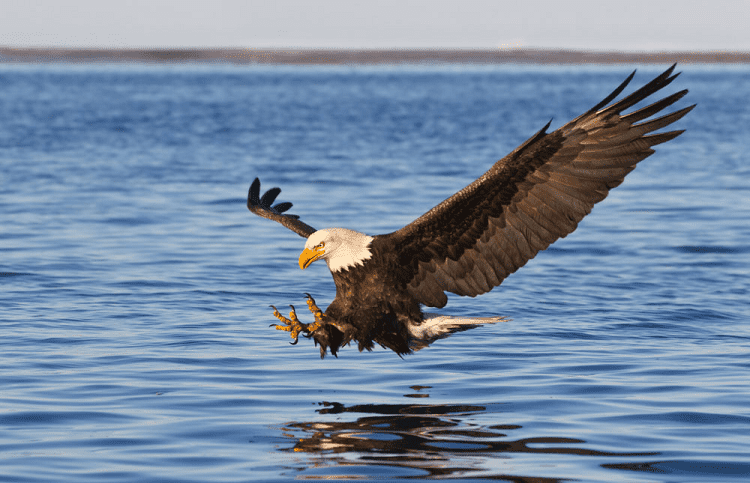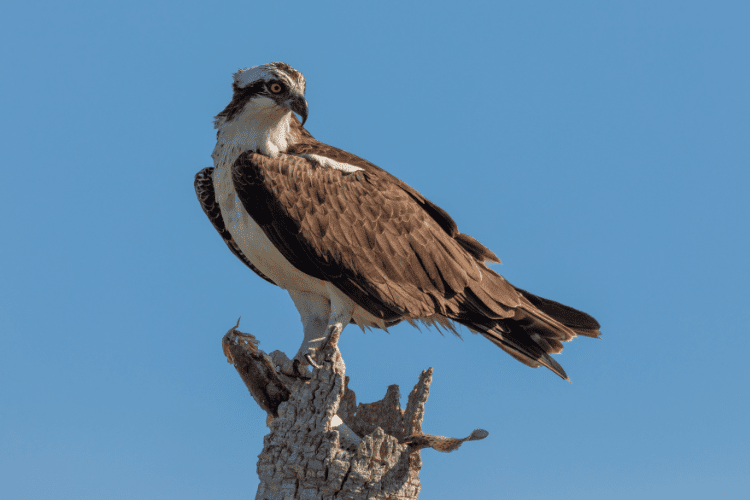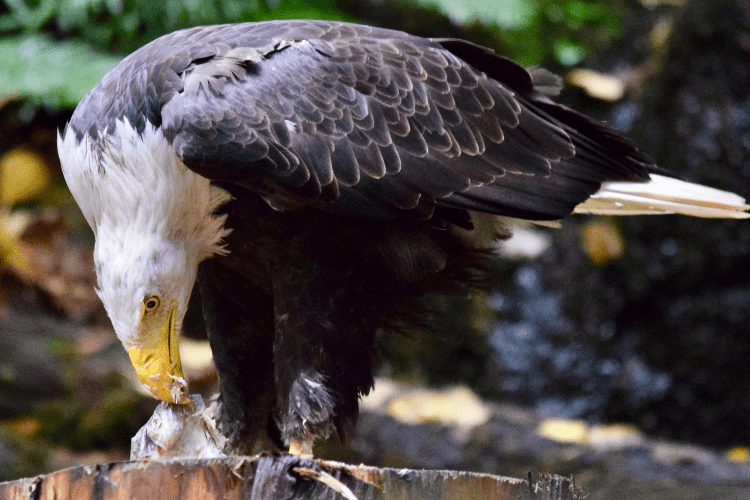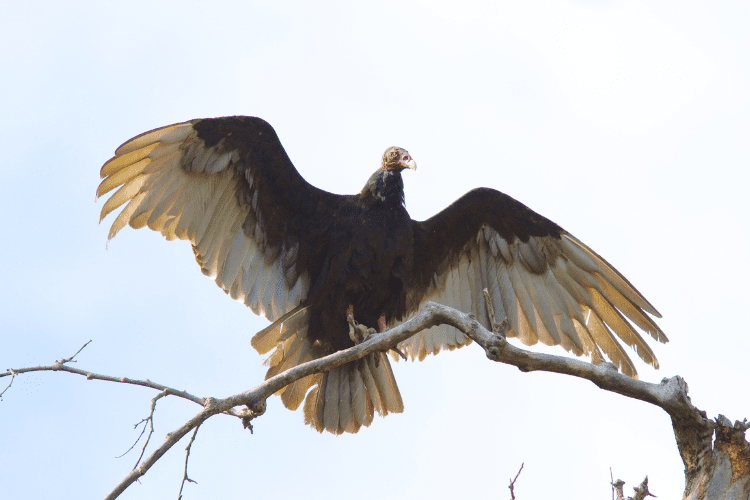- Best Amazon Bird Baths Guide - September 26, 2023
- Best Copper Bird Baths - August 30, 2023
- Best Bird Baths Available at Home Depot - August 26, 2023
Look up…way, way up. It’s a bird, it’s a plane, it’s…either an osprey or a bald eagle. Actually, it could be a turkey vulture or a golden eagle too, but we’ll get to that.
Large birds soaring high in the sky evoke feelings of freedom and power. After all, we’d all love to have an ‘eagle’s-eye view‘ of the world, looking down from on high at trees that look tiny and the blue dots of lakes.
Who wouldn’t want to soar away from their problems, gliding along with fluffy clouds and the bright sun above? While we can’t actually do that, we certainly can look for and admire the birds that inspire these feelings.
The Bottom Line
These two powerful species are each impressive in their own way. The larger bald eagle is an opportunistic predator and scavenger, while the uniquely piscivorous osprey requires open water for hunting its fishy prey.
Both have suffered from pesticide poisoning but their populations have recovered, and are once again icons of nature.
Main Differences
In summary, bald eagles are larger, have dark bodies and wings, pure white heads and tails as adults, yellow bills and feet, and do not dive underwater, while the smaller osprey has a white body, white head with a dark eye stripe, wings that are dark on top and white with a dark wrist patch underneath, a two-toned grey/black bill and white feet, and only catch fish which may involve diving underwater.
How are these Birds Classified?
Both ospreys and bald eagles are known as birds of prey, or raptors, and this group of birds first appeared around 44 million years ago.
These birds have keen eyesight for spotting their prey (they hunt mammals, birds, or reptiles), sharp beaks for tearing flesh, and strong talons (claws) for holding onto their prey (except for vultures).
The osprey is a unique bird of prey, because it hunts fish, while other fish-eating birds (like kingfishes or penguins) have different adaptations for capturing their aquatic prey. Other raptors include hawks, falcons, owls, and vultures.
However, from a phylogeny (evolutionary relatedness) perspective, raptors are not a single group, indicating that the raptor lifestyle has evolved multiple times.
Since osprey are unique among the raptors in their traits for specializing on fish, they are a separate group from the other raptors.
They are both in the Kingdom Animalia, Phylum Chordata, Class Aves, and Order Accipitriformes, but then they split, with bald eagles (and harriers, hawks, kites, and vultures) all in the Family Accipitridae, but only ospreys in the Family Pandionidae.
Range
If you live in North America, this is the only place where bald eagles and ospreys co-exist. Bald eagles only live in North America, while ospreys have a global distribution.
Because of their different feeding habits (ospreys require open water to catch fish), ospreys migrate to Central and Southern America for the winter with a few pockets occurring in California and Florida, while bald eagles overwinter throughout southern Canada and most of the US.
That’s why it is during the spring to fall in most of North America where you may see either species and want to know which large raptor you’ve spotted.
Size
Both these species are large. In fact, bald eagles are the second largest soaring bird in North America, only coming second to the California condor, and are slightly larger than golden eagles. With a wingspan of 7 feet or more, they are big!
Ospreys have a wingspan up to 6 feet, so they are no slouch when it comes to size. However, unless you have a lot of practice, it can be hard to know exactly how large a single individual’s wingspan is when in flight – so let’s look at other ways to tell these species apart.
Coloration
An adult bald eagle and an osprey have similar black-and-white coloring – dark wings and a white head. However, an osprey has a broad dark stripe through their eye that extends to the back of its head, while an adult bald eagle’s head is entirely white.
An adult bald eagle also has an entirely white tail, while an osprey has a banded tail. From underneath, note the coloring of the wings. An adult bald eagle has all dark wings and body, with a white head and tail.
An osprey also has a white head from underneath, but the body is also white, and the wings are mainly white (there is light banding on the flight feathers) – with the exception of a dark patch on the wrist.
Most people know what an adult bald eagle looks like – it is, after all, the emblem of the United States. But bald eagles take 5 years to reach their adult plumage, and though juveniles are adult-sized, they look different.
Juveniles start with a dark head, and each year as they get older, more white feathers are molted into their plumage. Their body and wings undergo the opposite pattern – they start out with more light-colored feathers, and each year they get replaced with darker feathers.
You can actually age bald eagles for the first five years of their life based on how much white they have in their feathers. Juvenile ospreys look very similar to adults, except for white spotting on their feathers, which they lose when they molt into adult plumage in their second year.
Other Differences
There are other, more subtle traits that distinguish between these species. Though they both have the large beaks and strong feet of raptors, but the beak of a bald eagle is very large, being dark in a juvenile and yellow in an adult.
The upper legs of bald eagles are feathered and so are dark, while the lower legs and feet are yellow, with thick claws. Ospreys are more delicate in this regard, with smaller more hooked bills that are blue-gray at the base and black at the tip, white legs and feet, and long sharp claws.
In a lot of movies, the majestically soaring bald eagle appears to make a distinctive scream. But that scream is actually the call of a red-tailed hawk that has been edited into the scene!
Instead, the voice of a bald eagle is more of a cackle, whistle, or kak-kak-kak. An osprey sounds different, and in fact, for a bird of that size, their voice is surprisingly mild – a high-pitched whistle, or cheep, is their common call.
Diet
Hunting behavior is another way to tell apart these two species. Both can feed on fish, though the osprey exclusively relies on piscine prey, while the bald eagle will also take mammals and birds. However, it’s their approach to capturing prey that sets them apart – if you’re lucky enough to see it.
That’s because ospreys are the only bird of prey that will dive into and under the water to capture food. After spotting its prey, an osprey dives, extending its legs forward and folding its wings back before hitting the water, with eyes locked on the target fish.
The osprey may become completely submerged if the fish is deep enough, but they can see underwater and can fly away after thanks to very waterproof feathers.
Bald eagles are much more willing to be scavengers, eating carrion, foraging at dumps, and sometimes trying to steal the prey of other predators, including fish from ospreys (a behavior termed kleptoparasitism).
Nesting
Bald eagles nest in tall trees, usually conifers, that provide a good view of their surroundings and a clear flight path. They build a nest high in the tree, but not at the crown – instead, the nest is built near the trunk, where strong branches fork out as their base.
Eagle nests are huge, up to 6 feet in diameter, and are often reused year after year, with new material added, consisting of large sticks for the base, then smaller sticks and twigs to fill the gaps, and mosses, forbs, and feathers to line the nest.
Both males and females bring materials to create the nest and may take up to three months to finish construction. However, where trees are not available (such as Alaska, or coastlines) they will nest on the ground, often on cliffsides. They tend to nest away from human activities.
Big birds require a lot of time to raise big babies – and so not surprisingly, bald eagles can only raise one brood a year, with 1-3 eggs that may all survive if food is abundant.
Both parents incubate, the eggs take about 35 days to hatch, and the chicks take 8-14 weeks to fledge, though they often stay in the vicinity of the nest for a couple more months, continuing to be fed by their parents.
You can watch live feeds of eagles at several nesting sites, from courtship to nesting building to egg incubation and fledging.
Ospreys prefer to build their nest right at the top of trees. They readily use nesting platforms, often placed to either encourage ospreys to nest in suitable locations where large trees have been lost, or to discourage them from using nearby man-made structures like power line towers.
They need fishable open water within about 12 miles of the nest to get food, which constrains nest placement on a landscape scale.
Osprey nests tend to be smaller than eagle nests, but can reach comparable sizes – usually around 3 feet in diameter, but can reach up to 6 feet. Like eagles, osprey will reuse nests each year, and the males bring most of the material to the nest.
It’s a lot of work to raise osprey chicks too – so they also only raise one brood a year, with 1-4 eggs being incubated for 36-42 days, and taking 7-8 weeks to fledge. Males do most of the foraging especially early on, with females staying with the chicks.
There are live feeds of osprey nesting activity too, so make sure to check some out!
Other Similar Species
The other most common bird you may mistake for a soaring osprey or eagle is a turkey vulture, which are far more common, and with a wingspan of 6 feet, as large as an osprey.
The easiest way to tell turkey vultures apart from eagles or ospreys is the shape of the wings in flight – when viewed from the front, the wings of a vulture form a V-shape, while eagles and ospreys soar with a flat profile.
If you’re close enough to see or have binoculars, you would notice the silver flight feathers and black coverts (the part along the arms), so their wings appear distinctly two-toned. When viewed from underneath, ospreys often have their wings bent at the wrist, while the wings of an eagle are usually kept straight.
Golden eagles look very similar to bald eagles, especially immature individuals. Immature golden eagles have a white tail but it ends in a dark band, and the head is dark. Mature golden eagles are uniformly dark, with a golden color to the feathers at the back of the neck.
From underneath, the white banded tail of the immature golden eagle is visible, in addition to white at the base of its primary feathers, whereas the mature golden eagle is dark overall.
FAQs
Answer: No, not at all. Adults have a white head and tail, with a dark body, and ‘bald’ refers to an older usage of the word, which refers to ‘white’ instead of ‘hairless’. Have you ever heard of a piebald horse?
That means it has two colors – and that’s the origin of ‘bald’ for the eagle, referring to the white portion of the body. Even their scientific name, Haliaeetus leucocephalus means ‘white-headed sea eagle’. Interestingly, vultures do have bald heads, an adaptation to their lifestyle of eating carrion.
Answer: Yes! Both species are pair-bonded during breeding and defend their nests against intruders, but during the non-breeding season, they can be found in groups.
However, ospreys are only ever found in small groups, usually less than 10, while bald eagles may gather in the hundreds at abundant food sources.
Answer: Huge. The largest bald eagle nest measured was 9.5 feet in diameter, 20 feet deep, and weighed 2.2 tons.
Answer: You’re probably lucky enough to be watching a male osprey’s courtship! Known as the ‘sky-dance’, the male brings a fish or nesting material to the nest site, hovers in the air, and makes a screaming call to attract a female.
Conclusion
You should count yourself lucky to see either a bald eagle or an osprey. Both species were impacted by the widespread use of DDT (dichloro-diphenyl-trichloroethane) which caused thinner eggshells and therefore reproductive failure and population declines.
After this chemical was banned, both species increased in abundance, and today, with patience, you can spot both of these magnificent raptors.
Though both are clearly amazing predators, I’ve personally always gravitated to the finely honed hunting techniques of the osprey – the outstretched talons, the locked-on golden eyes; there’s something simply mesmerizing about the intensity of their gaze.
However, if you prefer pure power and size, then the bald eagle is the one for you.
References:
- https://www.sciendo.com/article/10.2478/orhu-2014-0008
- https://meridian.allenpress.com/rapt/article/53/4/419/436631/Commentary-Defining-Raptors-and-Birds-of-Prey
- Anthony, R. G., & Isaacs, F. B. (1989). Characteristics of bald eagle nest sites in Oregon. The Journal of Wildlife Management, 148-159.
- Andrew, J. M., & Mosher, J. A. (1982). Bald eagle nest site selection and nesting habitat in Maryland. The Journal of Wildlife Management, 382-390.
- https://archive.org/details/baldeagles00dudl/page/7/mode/2up
Looking for more interesting readings? Check out:


